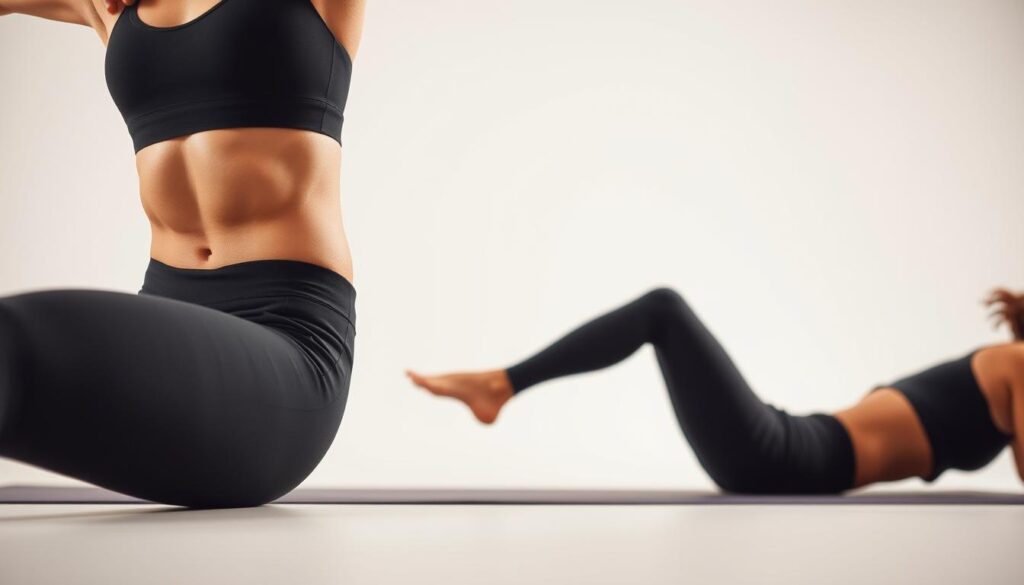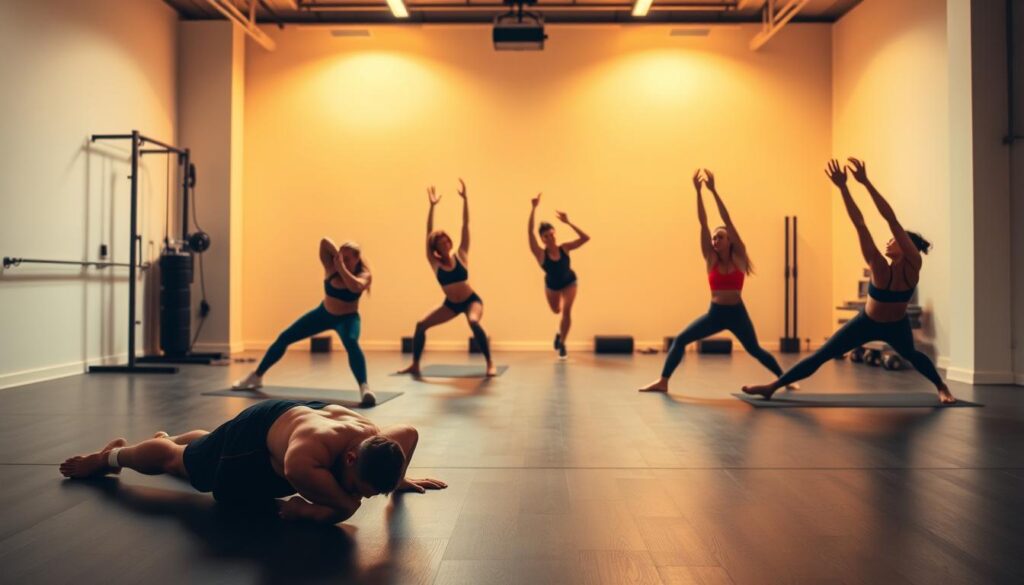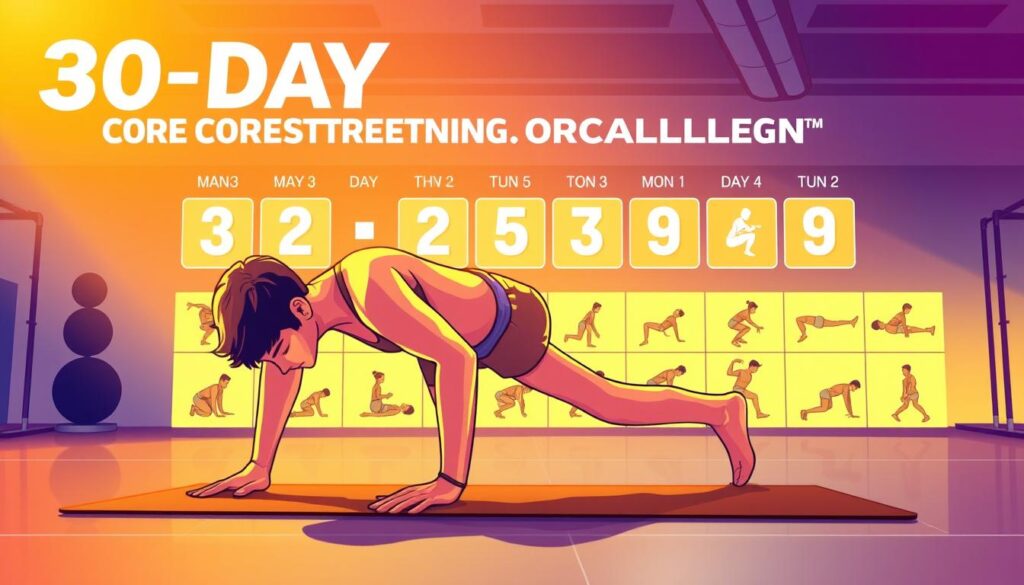Ever tried carrying groceries while balancing a toddler on your hip? Or felt your back ache after a long day of sitting at your desk? Your core isn’t just about looking strong—it’s the foundation for everything you do. But let’s be honest: carving out hours for fitness feels impossible when life moves at warp speed.
That’s where this program shines. Designed for real people with packed schedules, it delivers results in 10 minutes daily. No gym memberships. No complicated equipment. Just smart, science-backed moves that adapt to your fitness level—whether you’re new to exercise or training for a marathon.
Forget endless crunches chasing a six-pack. This challenge focuses on what matters: stability for lifting heavy boxes, endurance for chasing kids, and confidence that radiates from the inside out. Each workout includes two versions—gentle starters for day one and spicy upgrades for week three.
Key Takeaways
- Fits into even the busiest routines with short, effective sessions
- Builds practical strength for daily tasks through functional movements
- Offers adjustable difficulty levels for all experience levels
- Prioritizes long-term health over temporary aesthetic goals
- Requires minimal equipment and space to complete
By day 30, you’ll notice changes—not just in how you look, but in how you move through the world. Ready to rewrite what your body can do?
Introduction to the 30-Day Ab Challenge
What if 10 minutes could redefine your stability for daily tasks? This program reshapes traditional fitness approaches through smart progression. Unlike rigid plans demanding hours of effort, it uses time-efficient sessions that evolve as your midsection adapts.
Week one focuses on mastering bodyweight basics. You’ll learn to activate deep muscles like the transverse abdominis through controlled movements. Proper alignment matters more than speed—each rep builds a safer, stronger foundation.
By week three, workouts incorporate resistance to target oblique muscles and upper abs. The structure alternates between timed holds and dynamic reps, keeping your body guessing. Three key features make it stand out:
- Adaptive difficulty levels matching your progress
- Clear form cues preventing strain
- Minimal equipment needs
You’ll commit to brief sessions every day, but the real magic happens between workouts. Stronger abs improve posture during Zoom calls and power during weekend hikes. This isn’t about endless reps—it’s about creating a resilient center that supports your busiest days.
Understanding Your Core and Its Importance
Imagine lifting a heavy suitcase off a carousel without wincing. That power comes from layers of abdominal muscles working together like nature’s weightlifting belt. Your core isn’t just surface-level aesthetics—it’s a complex system protecting your spine during every twist, bend, and reach.
- Spinal flexion: Curling forward (like folding laundry)
- Bracing: Stabilizing during lifts (think holding a child)
- Rotation: Swinging a golf club or reaching across a desk
- Anti-rotation: Resisting sideways pulls (carrying groceries one-handed)
The visible rectus abdominis (your “six-pack” muscle) handles forward motions. But the real MVP is the transverse abdominis—a deep muscle corset that stabilizes your trunk. When weak, it’s like building a house on shaky foundations.
Strong abdominal muscles do more than prevent back pain. They:
- Improve breathing efficiency
- Enhance balance during uneven terrain walks
- Reduce injury risk during sudden movements
Every time you laugh, sneeze, or climb stairs, your core muscles engage. Training them isn’t about vanity—it’s about moving through life with ease and confidence.
Getting Started: Preparing for Your 30-Day Ab Challenge
How much space do you really need to transform your midsection? Clear a floor area the size of a yoga mat—that’s your new fitness command center. This setup works in apartments, offices, or hotel rooms, proving effective exercise doesn’t require fancy gear.
Essential Equipment and Setup
A cushioned mat protects your spine during floor movements. While most routines use your body weight, keep these extras nearby for advanced days:
- Light dumbbells (water bottles work)
- Resistance band (loop style)
- Folded towel for neck support
Assessing Your Fitness Level
Before day one, test your baseline. Can you hold a 20-second plank without shoulder sagging? Perform five controlled crunches without neck strain? Modify any exercise causing back discomfort—knees bent or reduced range of motion often help.
Schedule sessions when energy peaks—morning coffee drinkers might pair workouts with sunrise. Night owls could slot them between dinner and TV time. Consistency matters more than clock positions.
Remember: Your body adapts faster when you listen to its signals. If a movement feels wrong today, choose the modified version. Tomorrow’s floor session will feel different as strength builds.
30-Day Ab Challenge: Strengthen Your Core in Just One Month – Program Breakdown
Think you need hours to build a resilient midsection? This smartly structured plan delivers measurable progress in bite-sized sessions. Daily workouts grow from 5 to 15 minutes, fitting seamlessly between meetings or family time.
The first seven days establish fundamental patterns. You’ll master exercises like dead bugs and modified planks in 30-second bursts. These movements teach proper breathing and alignment—critical for avoiding strain.
| Week | Focus | Time/Day | Key Moves |
|---|---|---|---|
| 1 | Muscle Activation | 5-8 mins | Bird Dogs, Knee Tucks |
| 2 | Endurance Building | 10-12 mins | Side Planks, Bicycle Crunches |
| 3 | Dynamic Control | 12-15 mins | Plank Reaches, V-Up Holds |
| 4 | Integrated Strength | 15 mins | Circuit Training Combos |
By week three, you’ll tackle advanced variations that challenge rotational stability. The final phase blends exercises into flowing sequences—mimicking real-world movements like lifting luggage or playing tag with kids.
Rest days aren’t scheduled, but active recovery techniques are woven into tougher sessions. This approach maintains momentum while letting muscles adapt. Every seven-day cycle introduces new skills, keeping your abs engaged without plateauing.
Weekly Workout Structure and Progression
Structured progression turns brief efforts into lasting results. Each week builds skill and stamina through strategic exercise sequencing. The 30-second work-to-rest ratio stays consistent—your muscles adapt to smarter challenges instead of longer sessions.
Week 1 uses four rounds of 30-second moves like seated marches. Equal rest periods let you focus on form. This phase teaches muscle memory for foundational patterns. By day seven, your body learns to engage deeper core layers automatically.
Week 2 introduces single-side exercises. Unilateral bird dogs and side planks address muscle imbalances. The timing stays identical, but controlled rotations demand sharper focus. Combination workouts blend stability holds with dynamic reps midweek.
| Week | Focus | Challenge Days |
|---|---|---|
| 3 | Multi-directional moves | Rotational circuits |
| 4 | Integrated sequences | Nonstop flow drills |
Final stages prioritize real-world functionality. Week four’s circuits mimic lifting groceries while pivoting. You’ll string moves together with seamless transitions—no pauses between exercises. This trains endurance for life’s unpredictable demands.
Every time you hit the mat, the clock becomes your coach. Thirty seconds of work. Thirty to recover. This rhythm prevents burnout while building resilient muscle fibers. Progress happens through smarter movement patterns, not just brute effort.
Detailed Daily Core Workouts
Effective workouts fit into coffee breaks yet deliver lasting results. Each session uses precise timing to maximize muscle engagement without draining your schedule. You’ll alternate between 30-second bursts of activity and equal recovery periods—a rhythm proven to boost endurance safely.

Tailoring Moves to Your Level
New to core training? Start with modified versions that reduce strain. For planks, keep knees grounded instead of balancing on toes. Lower hold times from 30 to 15 seconds if needed. Advanced exercisers can intensify moves like bicycle crunches by adding 2-pound weights or extending holds to 45 seconds.
| Exercise | Beginner | Advanced |
|---|---|---|
| Plank | Knees down (20 sec) | Feet elevated (40 sec) |
| Crunches | Feet flat, 8 reps | Weighted, 12 reps |
| Side Plank | Bent knees (15 sec) | Leg lift added (30 sec) |
Smart Timing for Better Results
The 30:30 work-to-rest ratio keeps sessions sharp and sustainable. Day one might include three rounds of knee tucks (30 seconds) followed by rest. By week two, you’ll progress to five rounds with shorter breaks. This method trains your muscles to recover faster between exercise sets.
Always prioritize form over speed. If an exercise feels shaky, reduce reps or extend rest by 10 seconds. Consistency with proper technique beats rushed movements every time.
Key Core Exercises Featured in the Challenge
What separates a basic crunch from movements that truly fire up your entire midsection? This program uses plank variations and dynamic patterns to engage every layer of abdominal muscles. You’ll build strength through positions that mimic real-world motions—from lifting packages to twisting during sports.
Planks and Their Variations
The classic plank position serves as your foundation. Beginners start with forearm holds to master spinal alignment. As endurance improves, try these upgrades:
| Exercise | Primary Focus | Progression |
|---|---|---|
| Side Plank | Obliques | Add leg lifts or rotations |
| Plank Reach | Shoulder stability | Use light weights |
| Up-Down Plank | Full-body coordination | Increase tempo |
Each variation challenges your obliques and deep core muscles differently. Focus on maintaining a straight line from ears to ankles—no sagging hips allowed.
Dynamic Ab Movements
Combine strength with agility through flowing sequences. Situps with cross-body punches train rotational power, while hollow rocks improve spinal control. For advanced athletes, the hanging leg raise progression builds lower ab definition.
Key dynamic exercises include:
- Russian twists with controlled pauses
- Thread-the-needle rotations in side plank
- Tipping hollow rocks for anti-rotation training
These movements target multiple core functions simultaneously. You’ll develop power for explosive actions and endurance for sustained efforts—all within 10-minute sessions.
Incorporating Functional Fitness into Your Daily Routine
Functional fitness isn’t just a trend—it’s your body’s secret weapon. The core exercises in this 30-day core program mirror movements you already do: twisting to grab a coffee mug, bending to tie shoes, or stabilizing while climbing stairs. This approach builds strength that works when life demands it most.

Every exercise serves a practical purpose. Rotational moves like Russian twists improve your ability to lift heavy bags without strain. Plank variations teach your muscles to stabilize during prolonged standing or sudden pivots. Even basic crunches enhance sitting posture by strengthening the deep abdominal layers.
Here’s how stronger core muscles upgrade daily life:
- Carrying groceries feels lighter with engaged obliques
- Chasing kids becomes safer through improved balance
- Desk slouching decreases as spinal support increases
This training style also boosts performance in sports and workouts. A stable midsection lets you swing tennis rackets harder, run longer without fatigue, or perfect yoga poses. It’s like upgrading your body’s central command system.
As you age, strength in these areas becomes vital. Simple acts like getting up from chairs or navigating icy sidewalks rely on core stability. Functional fitness isn’t about looking capable—it’s about being capable, no matter what your day throws at you.
Home Workouts: No Equipment or Minimal Equipment Needed
Transform your living room into a powerhouse with nothing but a mat and determination. This program thrives in compact spaces—your bedroom floor, office carpet, or even a patch of grass works perfectly. No gym? No problem.
Bodyweight Exercises Overview
Your body becomes the ultimate fitness tool. These moves build functional strength using gravity and smart positioning:
- Mountain climbers for dynamic abs engagement
- Reverse crunches targeting lower abdominal muscles
- Flutter kicks that challenge endurance
Perform them on any stable floor surface. A cushioned mat protects your spine during ground exercises while allowing full range of motion.
Optional Equipment Guidelines
While 90% of workouts need only your body, these tools can add spice:
| Tool | Use | Alternative |
|---|---|---|
| Resistance band | Intensify side planks | Towel loops |
| 5lb weight | Boost Russian twists | Water bottle |
Those wanting equipment can use code NML for discounts. But remember: consistency on your floor mat beats fancy gear collecting dust.
Combining the Challenge with a Balanced Diet and Cardio
What fuels your progress beyond daily core exercises? Visible abs emerge when smart nutrition partners with targeted training. Think of your body as a high-performance engine—it needs quality fuel and regular tune-ups.
Pair these workouts with protein-rich meals to repair muscles. Grilled chicken, Greek yogurt, and lentils build strength while keeping you full. For fat loss, maintain a slight calorie deficit through colorful veggies and controlled portions.
Cardio accelerates results by burning excess body fat. Three weekly HIIT sessions—like sprint intervals or jump rope circuits—boost metabolism for hours post-workout. This combo reveals sculpted abs while enhancing overall stamina.
Remember: A strong core starts in the kitchen and thrives with varied movement. Hydrate well, sleep deeply, and watch how small daily choices amplify your transformation.

